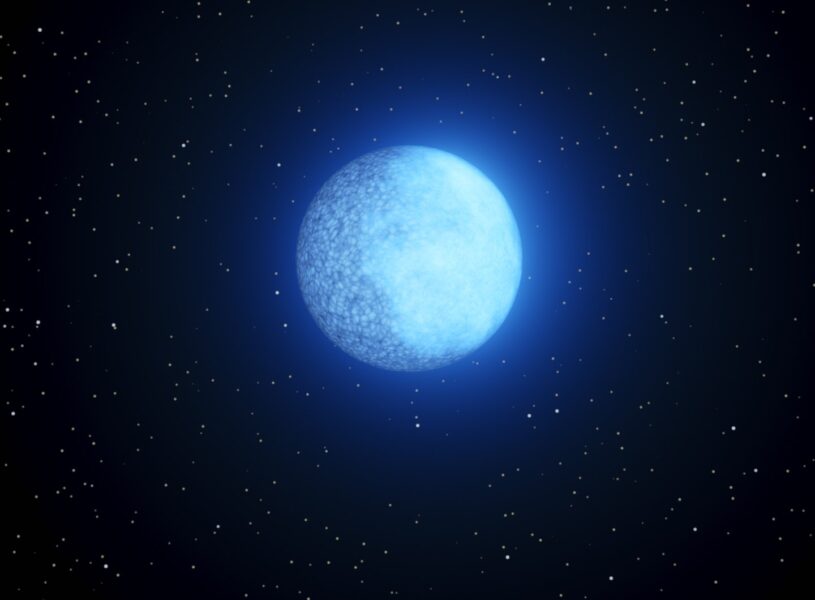The white dwarf J2033 seems to switch rapidly between two compositions.

K. Miller / Caltech / IPAC
Astronomers have found a bizarre, two-faced white dwarf: one side hydrogen, the other helium.
White dwarfs are the dense embers left behind when Sun-like stars die. They shove a Sun’s worth of mass into a sphere the size of Earth, giving them surface gravities some 100,000 times that of our world. As a result, the atoms in these erstwhile stellar cores separate by mass — the heavier stuff sinks, and the lighter stuff rises.
Since hydrogen is the lightest element, it winds up on top. Helium comes next. But sometimes when a white dwarf cools down from its initial blaze (more than 100,000 Kelvin) to a slightly less startling 35,000K, convection in the helium layer begins to dilute the overlying hydrogen. Eventually helium conquers, and the white dwarf continues its slow chill-out wrapped in a helium blanket.
Astronomers have seen a handful of white dwarfs that appear to have varying levels of helium across their surfaces, presumably because they’re in the midst of this hydrogen-to-helium transition. The newfound ZTF J203349.8+322901.1 may be an extreme example.
Ilaria Caiazzo (Caltech) and others discovered ZTF J2033 while using the Zwicky Transient Facility to look for white dwarfs that periodically change in brightness. Follow-up observations with ground- and space-based telescopes revealed something odd: The dwarf appeared to vary in both brightness and composition as it spun around every 15 minutes. When the brighter side pointed at Earth, the team detected only hydrogen in the dwarf’s spectrum; the other side showed only helium.
There’s no sign of a binary companion or pulsations that could explain the mismatch, the team reports July 19th in Nature. The difference must be in the star’s surface.
Caiazzo and her colleagues emphasize that they don’t know for sure why ZTF J2033 — which they’ve nicknamed Janus for the two-faced Roman god of transition — looks this way. But they think the best solution is magnetic fields.
White dwarfs can have intense magnetic fields, but it wouldn’t take much to cause Janus’s split personality. Localized to part of the surface, a field only a few dozen times stronger than those found in sunspots could choke convection in the area, preventing mixing. The helium side, conversely, would have a weaker field, enabling convection to erode the hydrogen layer.
Another option is that a magnetic field could create a section where the gas’s pressure and density drop. Hydrogen would tend to migrate there, forming an “ocean.”
We know magnetism can inhibit convection in white dwarfs, so invoking it here is “perfectly reasonable,” says Alexandros Gianninas (Connecticut College), who wasn’t involved with the research. In 2015 he and his colleagues found what appears to be a starspot on the white dwarf J1529+2928 — perhaps created by a concentrated magnetic field, just as the Sun’s freckles are. J1529 shares some spectral similarities with Janus.
“So there are certainly other white dwarfs we can look to that share some observational properties with ZTF J20233,” he says. “But it is most certainly the only one I know of that completely changes spectral types faster than it took me to write this email!”
Janus’s temperature of roughly 35,000K also puts it at the transition point for helium’s dominance, Caiazzo’s team says. It and its less extreme kindred may thus be bellwethers of an entire class of white dwarfs.
As J20233 cools, convection will overcome the local magnetic field and destroy the hydrogen layer. The object will complete its transition to a nondescript, helium-sheathed white dwarf.
Reference: I. Caiazzo et al. “A rotating white dwarf shows different compositions on its opposite faces.” Nature. July 19, 2023.
 6
6









Comments
Anthony Barreiro
July 25, 2023 at 10:36 pm
The Nature link only gives the abstract before I hit a paywall. It looks like there is a September 2022 preprint available:
https://www.researchgate.net/publication/363532432_A_rotating_white_dwarf_with_two_faces
ZTF J203349.8+322901.1 is under the eastern wing of Cygnus, about 2 degrees east of 39 Cygni. Parallax of 25 mas yields a distance of 40 parsecs or 130 light years. Absolute magnitude 12. I'm not good enough at math to figure out the apparent magnitude, but I'll bet somebody reading this knows how.
You must be logged in to post a comment.
Anthony Barreiro
July 26, 2023 at 5:53 pm
I found the formula relating distance, absolute magnitude, and apparent magnitude. ZTF J2033 is 15th magnitude.
You must be logged in to post a comment.
Lou
July 27, 2023 at 4:13 am
The paper is downloadable outside the paywall. 🙂 Omni Calculator came up with mag 20, which corresponds perfectly with the paper, which shows mag 20 with HiPERCAM's green filter!
You must be logged in to post a comment.
Anthony Barreiro
July 27, 2023 at 4:43 pm
Thank you Lou. I'm not good at math.
You must be logged in to post a comment.
robin_astro
July 29, 2023 at 7:38 am
It is magnitude 20 (G)
http://simbad.cds.unistra.fr/simbad/sim-basic?Ident=Gaia+DR2+1863529616173400576
Robin
You must be logged in to post a comment.
robin_astro
July 29, 2023 at 7:42 am
There are other brighter ones which show a similar effect though eg mag 14.5 (V) GD323
http://simbad.cds.unistra.fr/simbad/sim-basic?Ident=GD323
see this paper
https://iopscience.iop.org/article/10.1086/429219
You must be logged in to post a comment.
You must be logged in to post a comment.